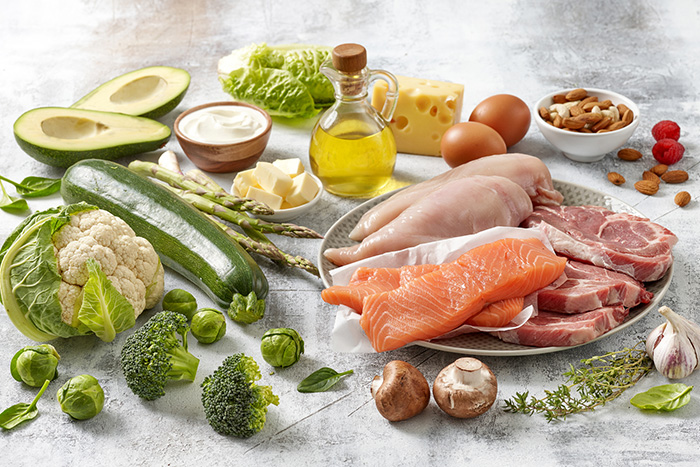What foods are on the Ketogenic Diet?
A keto plate will be made up of half a plate of meat and half a plate of low-carb veggies, with berries or nuts as a side. Meats can be any kind from beef to poultry to eggs to seafood. The veggies include leafy greens, cucumbers, asparagus, broccoli, cauliflower, and peppers.
All berries are encouraged as well as avocado and low-carb nuts like pecans, macadamia Brazil nuts or walnuts. Dairy, including cheese and heavy whipping cream, are also allowed.
What foods are not on the Ketogenic Diet?
The goal is to not eat any foods high in carbohydrates such as rice or grains like cereal, pancakes, bread, pasta, chips, or crackers. Also not on the table are sugar filled items like candy, cookies, pie, and cake. High carb fruits are a no-go as well.
What drinks are okay on a Ketogenic Diet?
Water, coffee, tea, and flavored waters with no sugar are the beverages allowed. Alternative sweeteners like stevia or monk fruit are on plan. A glass of wine occasionally is fine too, as long as the carbs are included in the daily total.
How many carbohydrates are on a Ketogenic Diet?
The protocol allows for the daily consumption of 20 grams of carbohydrates or less. There is some debate within the ketogenic community as to whether those should be 20 total grams or 20 net grams (carbs minus fiber), as it seems to work better one way for some and one way for others.
When can I eat on a Ketogenic Diet?
This is an individual decision for those following a keto lifestyle. If you eat when you are hungry and stop when you are full, you may find more time passing before you are hungry again. Start with three meals a day eating enough food to be satisfied until the next meal and see if you intuitively move to two meals a day. Snacking is discouraged.
What are the rules of a Ketogenic Diet?
At the core, to follow a keto plan, you will eat 20 grams of carbs or less each day in two or three meals a day without snacks. The healthy fat in the diet will allow you to be satisfied for the stretch between meals.
Does a Ketogenic Diet give all nutrients needed to sustain life, in other words, is it safe?
Yes, it includes all food necessary for health. The challenge is in keeping an ongoing consistency with 20 grams of carbs daily. Of course, if you are under a doctor’s care, are taking medication, have kidney disease or are pregnant, working with your doctor is the best course of action when beginning the Ketogenic diet.
Why is the Ketogenic Diet good?
It is an effective way to lose weight and begin eliminating sugar, processed seed oils and processed foods from your diet. It lowers insulin levels and evens out blood sugar. There is also a lot of freedom and choice among meat and vegetables on the plan, so favorites can be found and enjoyed. Keto has been shown to reduce hunger, reverse diabetes, reduce blood pressure, improve fatty liver disease and help those get relief from autoimmune symptoms..
What are the side effects of a Ketogenic Diet?
Here enters the most commonly discussed symptom of keto which is “keto flu.” It is not particularly fun but it is not dangerous when approached with a gradual plan. After about two weeks of easing into a keto plan, any fatigue, headaches, cramps, interrupted sleep, irritability or diarrhea should subside. Some of these issues may indeed be withdrawal symptoms as you eliminate sugar and processed carbs from your plate. Oppositely, some experience constipation. Too much added fat or added dairy may have a negative impact on overall results. Individual balances can be determined through experimentation as it is not a one size fits all approach.
Are there health risks with a Ketogenic Diet?
The usual concerns include nutrient or vitamin deficiencies as well as cholesterol, or cardiovascular disease increasing due to the high fat, although even now the
ADA recommends a keto diet for those with Type 2 diabetes. If you are on medications they will need to be monitored for accurate dosing when reducing carbohydrates. Those with kidney disease should proceed with the proper plans in place.
What is the controversy with the Ketogenic Diet?
Sustainability long term is the biggest argument to overcome. It does take time and effort to determine carb counts and plan meals to accommodate them. Staying true to whole food options is what was intended, but now there are so many “keto” marketed products, it is hard to determine what fits the plan and if it is going to help you reach your goals or not.
What is a sample Ketogenic meal plan?
Breakfast ideas include:
Omelet with mushrooms, peppers and cheese
Scrambled eggs with bacon and avocado slices
Hard boiled eggs with tomato and mozzarella
Lunch ideas include:
Spinach salad with tuna and strawberries
Cheeseburger wrapped in lettuce with side salad
Grilled shrimp with zoodles (zucchini shredded like noodles)
Dinner ideas include:
Chicken stir fry with broccoli
Salmon with riced cauliflower
Taco salad, no shell
Keto is where many begin their path to better health. It often leads into other meat heavy elimination plans such as ketovore, carnivore and the lion diet, if needed. If this is your first time exploring ketogenic ways of eating, these are the four variations where people find relief from inflammation, obesity, food allergies and food addictions.


0 Comments